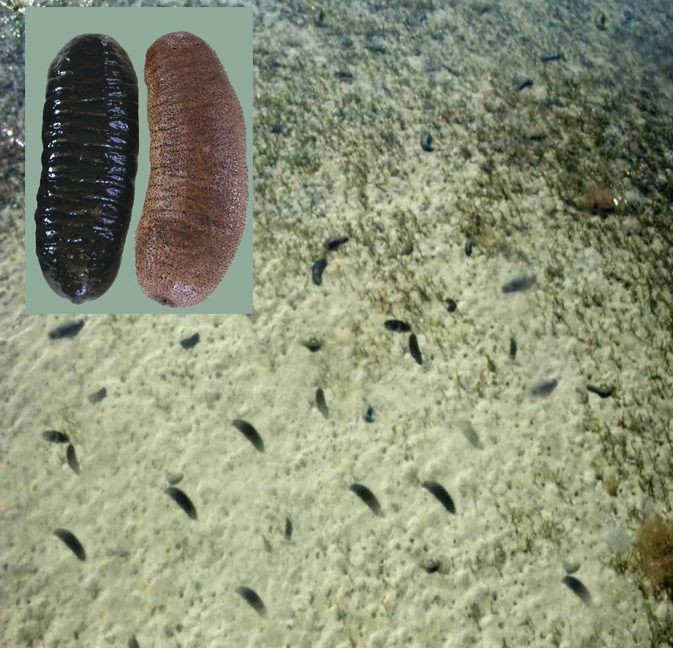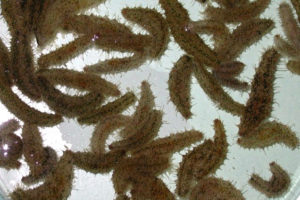Expanding, eco-friendly industry supplies Asian markets

Overexploitation is affecting wild populations of sea cucumbers worldwide. The demand for the “beche de mer” (processed dry product) is significantly increasing in Asia, promoting wild captures and making natural stocks more vulnerable to overfishing. Properly designed aquaculture and restocking programs are needed to meet the increasing demand and restore depleted fisheries to sustainable levels.
Over the past two decades, significant advances have been made in the culture of sea cucumbers, especially with the temperate species. Tropical sea cucumber species with excellent biological and market characteristics for commercial aquaculture have received much attention in recent years.
Since species like Holothuria scabra and H. lessoni have high potential as a lucrative export product for Asian markets, hatchery production and farming of these species presents an attractive aquaculture opportunity. These two species are popular in Asian cuisine and also used in Chinese traditional food and medicine.
Production technology
Research and development activities led by the Sea Cucumber Consultancy in a few countries during the last 15 years have led to tremendous progress in the areas of broodstock collection and management, induced spawning, larviculture, juvenile rearing, nutrition and the development of sustainable grow-out technology for hatchery-produced sea cucumber juveniles.
Since the successful hatchery production of sea cucumber juveniles by the authors’ team in Maldives during 2000, the protocols for sophisticated intensive hatchery production have been well established, and juvenile production efficiency has improved. Australia’s first sea cucumber hatchery, Bluefin Sea Cucumber Hatchery in Queensland, now produces millions of sea cucumber juveniles.
The authors are also undertaking projects in various Asian and Middle Eastern countries for the development of new sea cucumber hatcheries. The expanding industry is expected to boom in the next few years, when the new hatcheries begin producing millions of additional sea cucumber juveniles for grow-out in abandoned shrimp ponds.
Hatcheries

Commercial hatcheries for tropical sea cucumbers typically consist of broodstock-conditioning and management systems, and a mass culture unit for live feed (microalgae). Production involves larval rearing in the hatchery, juvenile rearing in the nursery and grow-out in ponds or shallow lagoons. The hatchery facilities usually include a water treatment system with a heating and chilling facility, aeration and feed distribution systems. The seawater supply systems incorporate inflow and outflow pipes, pumps and fine filtration.
Sea cucumber broodstock collected from the sea are induced to spawn in the hatchery, where the larvae are then cultured. The eggs hatch into Auricularia larvae within 48 hours after fertilization and start feeding on microalgae. The larvae then develop through the non-feeding Doliolaria stage before reaching the Pentacula stage. In 13 to 15 days, Pentacula animals are induced to settle in plates and are grown into juveniles. Early juveniles are maintained in the hatchery for one month and then for two months in the nursery.
Once the juveniles reach 3 to 5 cm, they are moved to grow-out preparation facilities in the sea or ponds for three months. They are then moved to pond or lagoon bottoms for further growth, or for sea ranching to rebuild depleted natural stocks.
The authors have developed two commercial sea cucumber hatcheries and are currently involved in the development of four more with state-of-the-art technology.
Perspectives
The commercial hatchery production of sea cucumbers and associated grow-out in abandoned shrimp ponds or sea-based marine farms for seaweed, mussels and finfish are economically attractive and environmentally friendly. They would also ensure a product supply to meet both the Asian markets and an emerging local market of Asian restaurants in other countries.
(Editor’s Note: This article was originally published in the July/August 2009 print edition of the Global Aquaculture Advocate.)
Now that you've finished reading the article ...
… we hope you’ll consider supporting our mission to document the evolution of the global aquaculture industry and share our vast network of contributors’ expansive knowledge every week.
By becoming a Global Seafood Alliance member, you’re ensuring that all of the pre-competitive work we do through member benefits, resources and events can continue. Individual membership costs just $50 a year. GSA individual and corporate members receive complimentary access to a series of GOAL virtual events beginning in April. Join now.
Not a GSA member? Join us.
Authors
-
Dr. Beni Giraspy
Sea Cucumber Consultancy
15 Milo Street
Hervey Bay 4655
Queensland, Australia. -
Dr. Grisilda Ivy Walsalam
Sea Cucumber Consultancy
15 Milo Street
Hervey Bay 4655
Queensland, Australia.
Tagged With
Related Posts

Responsibility
Sea cucumber project redefining traditional farming in Madagascar
Farming sea cucumbers – known as sea slugs in China – is changing people’s lives, giving rural workers in Madagascar a potential pathway out of poverty.

Health & Welfare
Probiotics improve nursery performance of juvenile sea cucumbers
While sea cucumbers are one of the most prized seafoods in China and Asia, their production suffers from suboptimal juvenile production. The use of proper feeds and overall management in the nursery can improve yield and survival.

Health & Welfare
Sandfish, profitable sea cucumbers, also supply bioremediation
Sandfish, a high-value sea cucumber, supports the aquaculture of other fish species by cleaning up waste on the bottoms of ponds or sea cages.

Innovation & Investment
Aquaculture in Canada: status, perspectives
Canada exports farmed seafood products to more than 22 countries and is the main seafood supplier to the U.S. market. Finfish, primarily salmon, production is strong and shellfish production is growing, but diversification will be imperative to maintain competitiveness.


